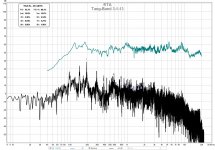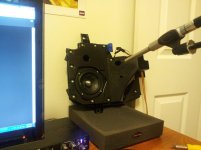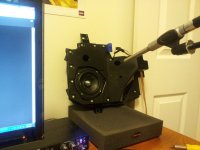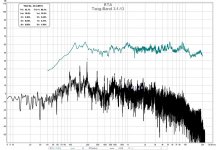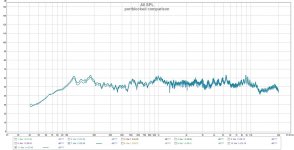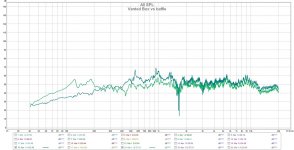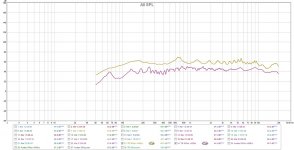Hey!
I felt that this topic would be better suited to the full range sub-forum since I decided to use a full-range home speaker, even though this is a car application. Additionally, I have been conducting extensive tests with a calibrated measurement microphone since first connecting my speaker to my Crown amplifier. If anyone thinks it should be in the car section though, you are welcome to move it.
Anyway, my Nissan 300zx originally came with four Bose speakers in special enclosures. The main defect here is that the individual amplifiers that power each speaker often fail and new speakers are usually cheaper than repairing the amplifiers. I had an expert on the Z forum install some Audax VP100z2 coaxial full range speakers in these enclosures, however I was never satisfied with the sound (these drivers break up at around 10khz and have a resonance frequency of around 100hz).
While my car was down for some work, I decided to replace a couple of the speakers with new Tang-Band W4-1052SDF's. I thought it best to test the first speaker in my room with my test equipment to reveal any problems. Although the speaker has not finished breaking in yet, I am rather dissatisfied with fidelity. Highs seem to roll off soon, however there is a nasty resonance at around 150hz. I took a screen shot of the last SPL sweep and RTA test that I conducted.
The port in this enclosure was approximately 12cm long when I checked last (along with a 90 degree bend) as well as 2.7cm wide. WinISD indicates that the port should be about this long in a rectangular box, however I do not know enough about this shape enclosure to make any conclusions. The enclosure appears to be about 2.5 liters in volume and I added a large amount of acousta-stuf. Also, I had to add a few layers of speaker gasket to the box and driver back to keep it from bottoming out.
What if anything should I try adjusting to remedy these problems? I'm most bothered by the peak at around 150hz and would love to move the boost to around 80hz. I am planning to add a subwoofer to take care of frequencies below 80hz, but I would like flat response from these speakers as far down as possible.
Here is a link to the driver that I am using:
Tang Band W4-1052SDF 4" Full Range Speaker 264-913
Attached are the screen shots!
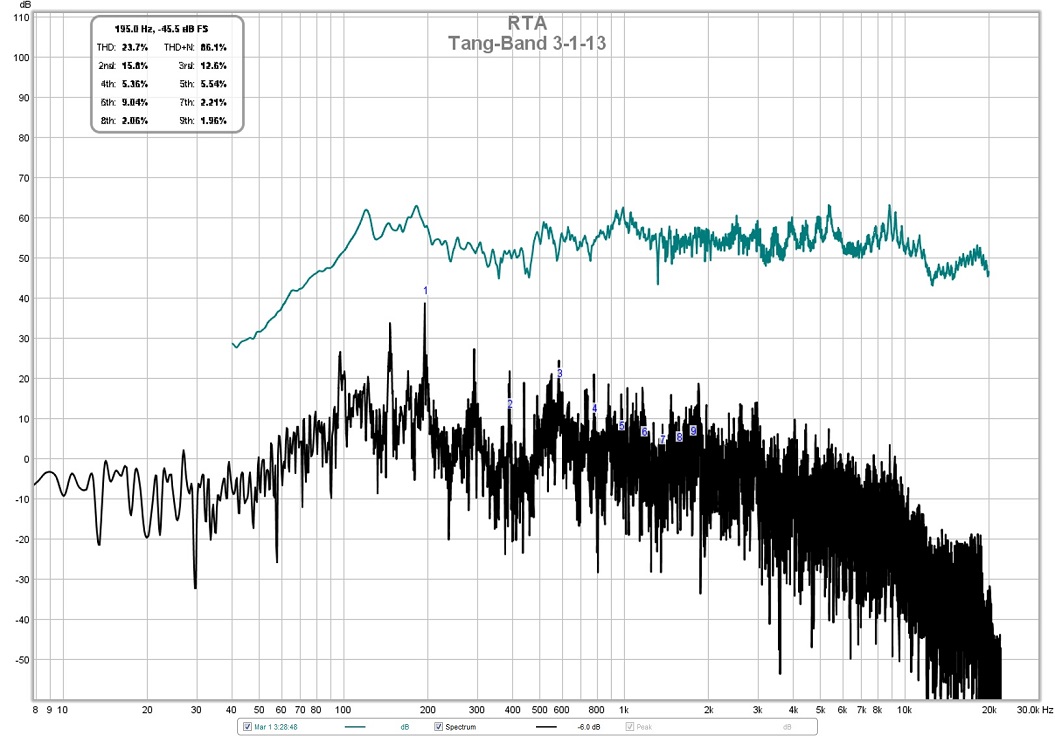
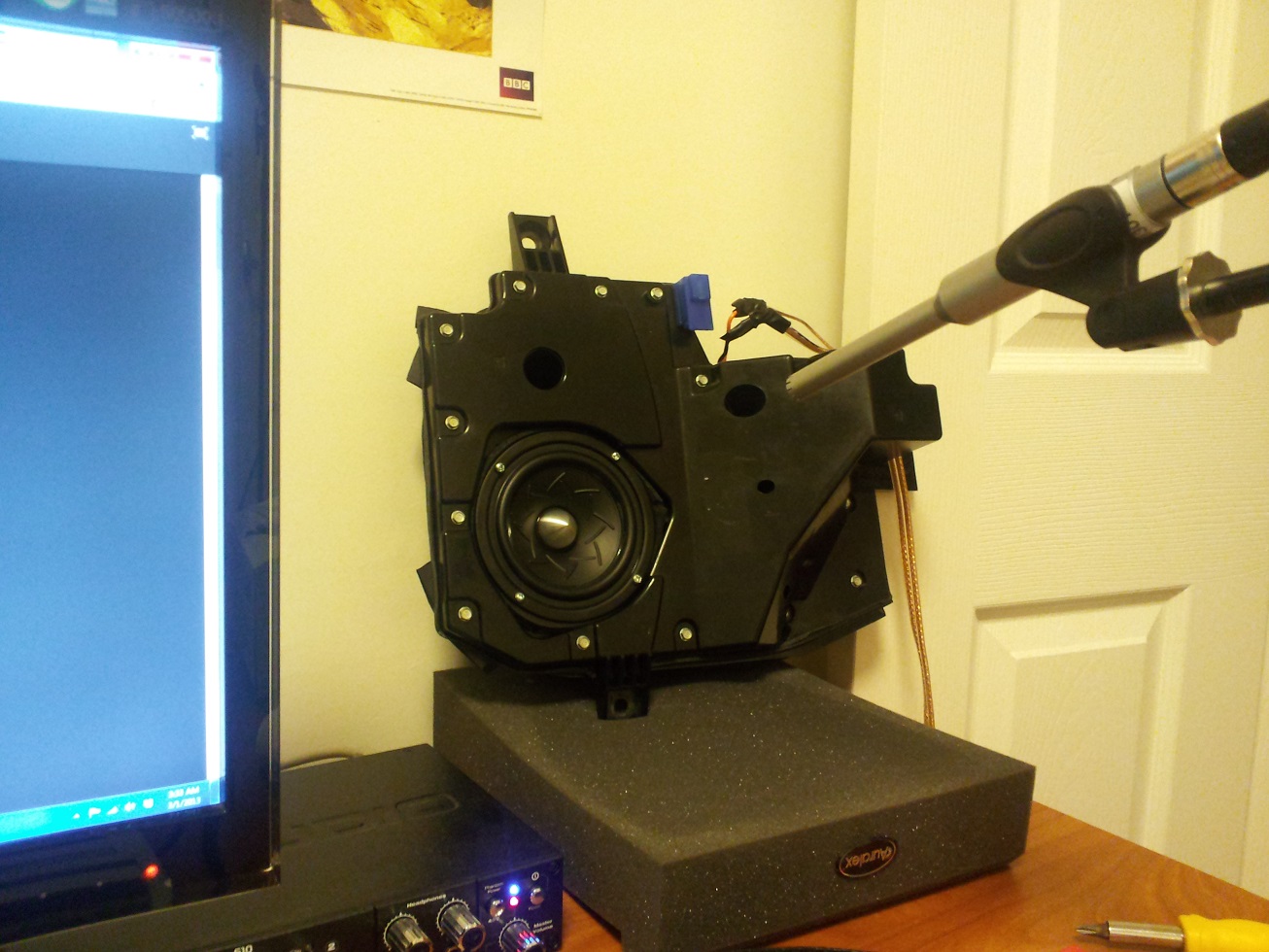
Thanks very much for your help!
I felt that this topic would be better suited to the full range sub-forum since I decided to use a full-range home speaker, even though this is a car application. Additionally, I have been conducting extensive tests with a calibrated measurement microphone since first connecting my speaker to my Crown amplifier. If anyone thinks it should be in the car section though, you are welcome to move it.
Anyway, my Nissan 300zx originally came with four Bose speakers in special enclosures. The main defect here is that the individual amplifiers that power each speaker often fail and new speakers are usually cheaper than repairing the amplifiers. I had an expert on the Z forum install some Audax VP100z2 coaxial full range speakers in these enclosures, however I was never satisfied with the sound (these drivers break up at around 10khz and have a resonance frequency of around 100hz).
While my car was down for some work, I decided to replace a couple of the speakers with new Tang-Band W4-1052SDF's. I thought it best to test the first speaker in my room with my test equipment to reveal any problems. Although the speaker has not finished breaking in yet, I am rather dissatisfied with fidelity. Highs seem to roll off soon, however there is a nasty resonance at around 150hz. I took a screen shot of the last SPL sweep and RTA test that I conducted.
The port in this enclosure was approximately 12cm long when I checked last (along with a 90 degree bend) as well as 2.7cm wide. WinISD indicates that the port should be about this long in a rectangular box, however I do not know enough about this shape enclosure to make any conclusions. The enclosure appears to be about 2.5 liters in volume and I added a large amount of acousta-stuf. Also, I had to add a few layers of speaker gasket to the box and driver back to keep it from bottoming out.
What if anything should I try adjusting to remedy these problems? I'm most bothered by the peak at around 150hz and would love to move the boost to around 80hz. I am planning to add a subwoofer to take care of frequencies below 80hz, but I would like flat response from these speakers as far down as possible.
Here is a link to the driver that I am using:
Tang Band W4-1052SDF 4" Full Range Speaker 264-913
Attached are the screen shots!
Thanks very much for your help!
Attachments
Last edited:
What is the tuning freq in WinISD? The response doesn't seem to go very low considering the fs of the driver is 70 hz. On bass reflex enclosures, you want to line the walls with damping material, like a half in thick layer of carpet padding, felt, or polyfill but formed into a sheet batting and glued to walls avoiding blocking of ports. A 12 cm long port sounds awfully long. Did you measure the actual volume by water or displacement or is it estimated? It makes a big difference when total vol is 2.5 liters - kind of small. Ideal volume is much bigger - that's probably the main problem.
Edit: I just checked WinISD, the ideal volume is 6.5 liters with 3.4 cm long port if port is 2.7 cm. This will get you a nice flat response down to 70 or 80 Hz. If you stuff this driver into a 2.5 liter enclosure with the port you have it rolls off at 170 Hz. That peak you see at 150 Hz is the overshoot of a non ideal alignment of an undersized box. The shape of the box should not matter. Do you have room to mod the box to triple its volume and cut the port length down? It just looks like driver is mismatched to enclosure. This driver appears to measure quite flat and nice as Tang Bands mostly do in this category.
Edit: I just checked WinISD, the ideal volume is 6.5 liters with 3.4 cm long port if port is 2.7 cm. This will get you a nice flat response down to 70 or 80 Hz. If you stuff this driver into a 2.5 liter enclosure with the port you have it rolls off at 170 Hz. That peak you see at 150 Hz is the overshoot of a non ideal alignment of an undersized box. The shape of the box should not matter. Do you have room to mod the box to triple its volume and cut the port length down? It just looks like driver is mismatched to enclosure. This driver appears to measure quite flat and nice as Tang Bands mostly do in this category.
Last edited:
What is the tuning freq in WinISD? The response doesn't seem to go very low considering the fs of the driver is 70 hz. On bass reflex enclosures, you want to line the walls with damping material, like a half in thick layer of carpet padding, felt, or polyfill but formed into a sheet batting and glued to walls avoiding blocking of ports. A 12 cm long port sounds awfully long. Did you measure the actual volume by water or displacement or is it estimated? It makes a big difference when total vol is 2.5 liters - kind of small. Ideal volume is much bigger - that's probably the main problem.
The tuning frequency in WinISD is 67.17hz. I just stuffed the entire thing with polyfill, so I am most likely blocking the port. I will take the box apart tomorrow and try gluing all of the polyfill to the walls.
I also only estimated the displacement. I can remove the driver, fill it up with water, and see the exact volume. I will also measure the exact length of the port.
I agree with you that the box is quite small. Unfortunately though, until I can find away to build a larger enclosure, this is what I am stuck with. :/ I'm just trying to optimize performance without replacing the enclosure.
Thanks!
Edit: I could probably add another 2 liters to the box through modifications. I might have to glue on a cut plastic box? Do you think that this would get me close enough to a reasonable response?
Last edited:
Pico, I'll definitely look at grabbing baffles! That should also help offset my speaker from the rear wall.
xrk- I stuffed a large amount of closed cell foam 2.5 inches deep into the port. I'm guessing that the port was already mostly blocked internally by the polyfill because I only saw a small reduction in that peak. The peak did fall by 2-3 db though and I cannot hear much of a resonance anymore.
I'm guessing that there is no way to keep this as a bass reflex enclosure without suffering from a large peak at around 150hz?
Thanks again
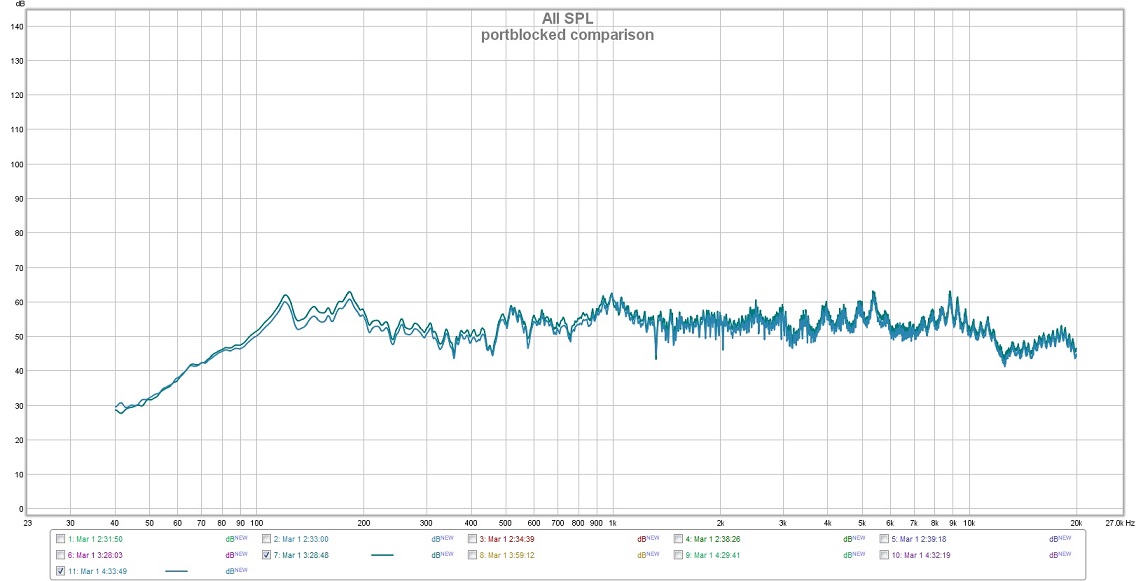
xrk- I stuffed a large amount of closed cell foam 2.5 inches deep into the port. I'm guessing that the port was already mostly blocked internally by the polyfill because I only saw a small reduction in that peak. The peak did fall by 2-3 db though and I cannot hear much of a resonance anymore.
I'm guessing that there is no way to keep this as a bass reflex enclosure without suffering from a large peak at around 150hz?
Thanks again
Attachments
That's not much of a difference which means your stuffing was blocking ports earlier. That box is probably resonating and mic is picking of secondary radiated sound from box walls. When mounted in car that will all be blocked. Try covering box surface with something to simulate car panels or dashboard. You can also try smaller driver like 3 in instead of 4. May need cutout adaptor.
Also the box: is that needed ?
Since the purpose of a box is to separate the front wave from the back wave, by removing it you just let the sound escape in all directions. You can control it by adding some stuffing behind, but pricipally you have to take care of all the resonances of all the
different panels & different materials. I think that the purpose of a plastic box is mainly to prevent moisture attack to the metallic parts of the speaker .
I frequently use tar+waste foils from automotive shops to 'damp' the internals of a cabinet
Since the purpose of a box is to separate the front wave from the back wave, by removing it you just let the sound escape in all directions. You can control it by adding some stuffing behind, but pricipally you have to take care of all the resonances of all the
different panels & different materials. I think that the purpose of a plastic box is mainly to prevent moisture attack to the metallic parts of the speaker .
I frequently use tar+waste foils from automotive shops to 'damp' the internals of a cabinet
Hey guys,
Thanks for all of the helpful replies. I took some time today to run some more tests.
First, I tested to see what the response was like without a box. I just removed the back of the box. Unfortunately, any semblance of bass was lost here. I've posted a spl chart. The dark green line is a test without the box while the light green line is a test with the properly vented box (acousta-stuff taped to the sides).
Then, I volume tested the box to the best of my abilities. 2 liters of water filled the back half of the box to the brim and .5 liters filled the small piece that is jutting out to the right of the speaker on the top half. There is additional space in the top half but this is difficult to measure. I'm guessing that it is approximately .5 liters, judging by the volume of the other parts. Thus, I can fairly safely assume that the box is 3 liters in volume.
Blocking the port doesn't seem to have much of an effect, but I know that the port is the wrong length. Although there is a bend in it, I've determined that the port is about 14 cm long! According to WinISD a vent of about 2.7cm in width should be 10.5 cm in a box approximately 3 liters in size. Should I cut the port back until it is 10.5 cm in length?
tuxedo, I know that this test environment isn't ideal. Neither is a car environment though so I would like to get the speaker performing the best it can before dropping it into my Z. I also can't feasibly take all of my test equipment to my car right now.
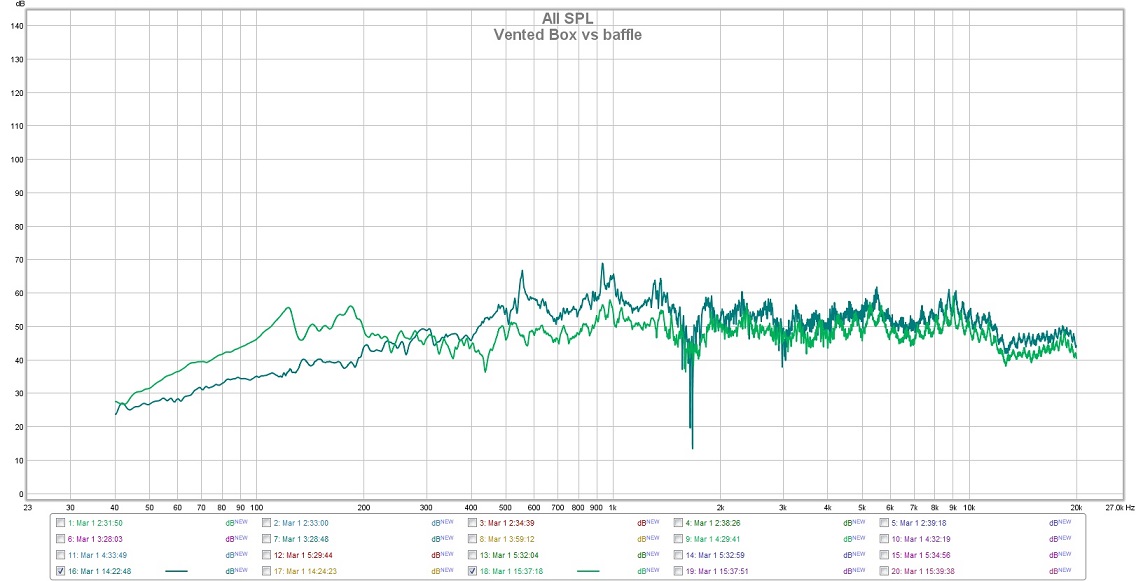
Thanks for all of the helpful replies. I took some time today to run some more tests.
First, I tested to see what the response was like without a box. I just removed the back of the box. Unfortunately, any semblance of bass was lost here. I've posted a spl chart. The dark green line is a test without the box while the light green line is a test with the properly vented box (acousta-stuff taped to the sides).
Then, I volume tested the box to the best of my abilities. 2 liters of water filled the back half of the box to the brim and .5 liters filled the small piece that is jutting out to the right of the speaker on the top half. There is additional space in the top half but this is difficult to measure. I'm guessing that it is approximately .5 liters, judging by the volume of the other parts. Thus, I can fairly safely assume that the box is 3 liters in volume.
Blocking the port doesn't seem to have much of an effect, but I know that the port is the wrong length. Although there is a bend in it, I've determined that the port is about 14 cm long! According to WinISD a vent of about 2.7cm in width should be 10.5 cm in a box approximately 3 liters in size. Should I cut the port back until it is 10.5 cm in length?
tuxedo, I know that this test environment isn't ideal. Neither is a car environment though so I would like to get the speaker performing the best it can before dropping it into my Z. I also can't feasibly take all of my test equipment to my car right now.
Attachments
Last edited:
tuxedo, I know that this test environment isn't ideal. Neither is a car environment though so I would like to get the speaker performing the best it can before dropping it into my Z. I also can't feasibly take all of my test equipment to my car right now.
True a car isn't a great acoustic environment. Neither are many living rooms. But if you want to "get the speaker performing the best it can" before working with it, and you plan to use measurements to do that, then you need to understand what the measurements mean.
You need reflection free measurements in order to be able to understand any shortcomings the driver has.
First, move the mic and speaker out in the the room away from walls and furniture. Prop the speaker up on a stand, about 4 feet off the ground.
Second, place the tip of the microphone about 2 inches away from the center of the cone.
Third, Take a sweep.
Fourth, Apply 24db/oct smoother.
Don't look at any of the response above 500hz, it's not very useful with this type of measurement.
Fifth, back the mic up about 2 feet from the driver.
Take a sweep.
Raise the right window time to 4ms. In REW, there is a button above the graph called window. Click on it. Change the right window to 4ms. Keep the smoothing at 24db or no smoothing.
Don't look at any of the response below about 500hz, it's not very useful with this type of measurement.
Now you have a complete on axis measurement which can tell you a tiny bit about how this speaker will perform. If you'd like to know more about how it'll perform, you'll need to:
1. Take an impedance sweep;
2. Take a series of off axis measurements;
3. Measure the sensitivity;
4. T/S parameters;
5. Harmonic distortion;
6. CSD;
7. And a few other things can help to.
i think the problem is two fold. I reckon the plastic is resonating, the port is too long versus its surface area also, and that you are suffering both. Not to mention that cabin gain and the intended location arent included in the measures. Id think that the remainder of the door structure may contribute to the enclosure rigidity.
Tuxedo,
Thanks a bunch for the recommendations! I followed them and measured my speaker from 2" and from 2 feet, then encorporated the time delay in the 2 foot measurement. I might not have done it correctly because I am using the new beta version of REW, but these results look much more consistent. Unfortunately, I didn't get them lined up but yellow is the <500hz measurement and purple is the >500hz measurement.
Clearly, there is a roll-off at around 13khz and gently sloping bass up until around 130hz with a bit of a boost at 65hz (which could be the work of the vent).
Do you think I could cut another .5-1cm off the length of this vent to move the bass boost up a bit more? It still isn't too boomy (except at the peak of 150hz).
What is your verdict on this speaker and do you think I could do anything else to improve it? I'm thinking about adding some EQ at around 16khz until I can install a couple of tweeters.
Thanks!
Thanks a bunch for the recommendations! I followed them and measured my speaker from 2" and from 2 feet, then encorporated the time delay in the 2 foot measurement. I might not have done it correctly because I am using the new beta version of REW, but these results look much more consistent. Unfortunately, I didn't get them lined up but yellow is the <500hz measurement and purple is the >500hz measurement.
Clearly, there is a roll-off at around 13khz and gently sloping bass up until around 130hz with a bit of a boost at 65hz (which could be the work of the vent).
Do you think I could cut another .5-1cm off the length of this vent to move the bass boost up a bit more? It still isn't too boomy (except at the peak of 150hz).
What is your verdict on this speaker and do you think I could do anything else to improve it? I'm thinking about adding some EQ at around 16khz until I can install a couple of tweeters.
Thanks!
Attachments
Much better, although the scales are really hard to read on the graph.
Things from 500hz and up look pretty decent imo, and I don't really see any problems. Sure, a little bit of roll off in the top octave. In a car way off axis this would likely be a large roll off. So eq will only help so much. But worth a shot.
I think the most telling thing is your nearfield, yellow line. Looks like a classic case of having an undersized vented enclosure. You could try moving up the tuning, but not sure how much that'll help. Any chance you could just run it sealed and cross your subs in a little high, like 120hz?
Things from 500hz and up look pretty decent imo, and I don't really see any problems. Sure, a little bit of roll off in the top octave. In a car way off axis this would likely be a large roll off. So eq will only help so much. But worth a shot.
I think the most telling thing is your nearfield, yellow line. Looks like a classic case of having an undersized vented enclosure. You could try moving up the tuning, but not sure how much that'll help. Any chance you could just run it sealed and cross your subs in a little high, like 120hz?
Much better, although the scales are really hard to read on the graph.
Things from 500hz and up look pretty decent imo, and I don't really see any problems. Sure, a little bit of roll off in the top octave. In a car way off axis this would likely be a large roll off. So eq will only help so much. But worth a shot.
I think the most telling thing is your nearfield, yellow line. Looks like a classic case of having an undersized vented enclosure. You could try moving up the tuning, but not sure how much that'll help. Any chance you could just run it sealed and cross your subs in a little high, like 120hz?
Tuxedo,
I was initially frustrated after reading your reply. Then, I realized that sealed enclosures might have been the best way to go all along. Correct me if I am wrong, but these Tang-Bands are apparently quite flat from ~200hz-13,000. I realized that this is a prime opportunity to drill out the ports and replace them with tweeters.
Do you think the following will work well?
Vifa OX20SC00-04 3/4" Fabric Dome Tweeter 264-1002
I could experiment with a crossover at anywhere from 10khz to 13khz to the tweeters and they should be fairly well phase aligned already due to placement.
If I can get everything in the high-end taken care of, I can cross over to a sub in my trunk at around 120hz like you recommend, then phase delay it properly with a 2x8 minidsp. Each driver would be driven independently by a 50 watt chipamp channel (except for the subwoofer).
Do you think that this is a "sound" plan?
Thanks again for your help!
P.S. My apologies for the wonky scale.
Last edited:
- Status
- This old topic is closed. If you want to reopen this topic, contact a moderator using the "Report Post" button.
- Home
- Loudspeakers
- Full Range
- Tang Band Full Range Tuning Frustrations!
